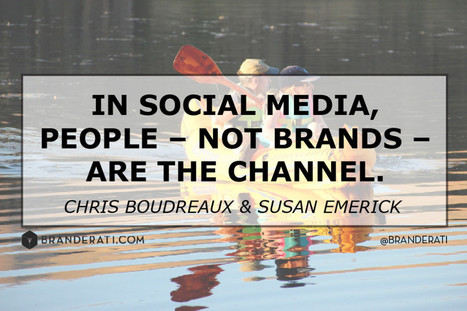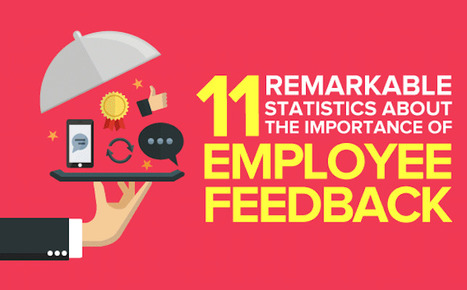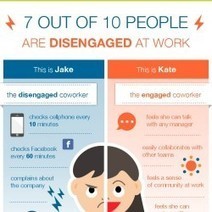 Your new post is loading...
 Your new post is loading...
Concerning internal communication elements critical for employee engagement, we found that satisfaction with feedback, informal communication and communication during meetings are the most relevant ICS dimensions for employee engagement. Our results confirm previous findings that feedback (e.g. Bakker & Demerouti, 2008), open channels of communication (e.g. Caesens, Stinglhamber & Luypaert, 2014), communication between supervisors and employees (e.g. Agarwal, Datta, Blake-Beard & Bhargava, 2012), and sharing information with employees (e.g. Durkin, 2007) are vital enablers of engagement.
However, even though our results imply a causal relationship between ICS and employee engagement (and even though engagement is mostly conceptualized as an outcome of internal communication, e.g. Ruck & Welch, 2012), what matters most is that internal communication and employee engagement “feed” each other in a continuous virtual circle.
Our results show that internal communication should be recognized as an underlying influence of employee engagement (Karanges et al., 2015). This implies that internal communication strategies, when effectively applied, help organizations to create and sustain high levels of employee engagement, which leads to higher levels of performance....
Early last year, our company, Duarte Inc., was well into a great season of change. We had turned our org chart on its side, so that nearly every person in the company either had a new boss or was a new boss. We had moved to a different building. We had implemented new software tools. We were about to release a new book. And we did all this while trying to perform our jobs at the highest possible level. People were tired and stressed. We knew deep down how much we really enjoyed and respected one another, but the pain of change made it difficult to for us to connect with that feeling. We had to do something special to rekindle it. So we set aside some time over the course of a week for employees to meet in small groups and talk about how we could best move forward, strong and united. Then, that Friday afternoon, everyone gathered in a large, open area in the office. The seats were arranged in a semi-circle, and a large drum stood in front of each seat. Over the next two hours, all of us (100-plus employees) beat our drums — first chaotically like a first-grade music class, and then, with the help of a music coach, in unison....
It’s the age-old conundrum for leaders and managers—we want to have motivated employees and we want their engagement, but do we have enough resources, the right people? Are we treating them right? How can we know?
Here’s how one tech support manager handles this challenge.
She just asks.Instead of worrying, guessing, and engaging in trial and error, Katie Douthwaite asks her teams the following four questions....
“And the web stormed the enterprise and disrupted roles, tasks and jobs: it cast speed, openness, flexibility and efficiency throughout, sparing no business processes: manufacturing, logistic, accounting, customer relation management, lead generation…”
The digital mutation is also profoundly disrupting how knowledge is acquired, organized and shared. Knowledge is an intangible, yet strategic asset of any enterprise. With businesses becoming more virtual and dematerialized, its value is patently and rapidly growing.
How does the enterprise adapt its Knowledge management practice to the digital age? Did the web annihilate the older knowledge management paradigms? How can the enterprise benefit, and not succumb, to a web-driven, pervasive and real-time knowledge? We at Scoop.it have noticed amongst our business clients a growing concern regarding the evolution of Knowledge sharing; we’ve run a survey (500 respondents) to better comprehend the challenges, objectives and stakes. Let’s share some insights....
Via Guillaume Decugis
The 2012 Edelman Trust Barometer, a trust and credibility survey that collects data from more than 30,000 people, found that regular rank-and-file company employees have more credibility than executives. While this might seem like bad news for companies – it should be considered a fantastic opportunity. By turning employees into trusted brand ambassadors, companies bring their strongest asset and their most vocal internal advocates in direct contact with their customer base....
|
Leaders of reorgs typically fall into one of two traps when communicating with their employees. We’ll call the first one wait and see and the second ivory-tower idealism. Perhaps you have seen one, or both, in your own reorgs.
In the first trap, wait and see, the leader of the reorg thinks everything should be kept secret until the last moment, when he or she has all the answers. The leader makes the reorg team and leadership swear to secrecy and then is surprised when the news leaks to the wider organization (it always does, we’re afraid). As the reorg team starts to engage with the rest of the organization, the rumors round the water cooler increase: “They were asking what my team does”; “I had to fill in an activity analysis form”; “I hear that 20 percent of jobs are going to go.” Everyone thinks the real reason for the reorg is job losses (whether it is or not). The leader, desperate to get in control of the situation, pushes the team to develop “the answer” so that he or she can tell the organization. Without an “answer,” the leader feels that any communication would come across as defensive. At most, the executive approves some question-and-answer sessions on the reorg. But a full-scale communication needs to wait. Eventually, the leader has the answer: the reorg team produces a high-level org chart. The leader then announces the new organization: here are the new leaders, here is the structure, some job losses are necessary, but this is going to help us deliver fantastic results. Employees, hearing this, hear only that their boss’s boss’s boss is going to change and that some of them are going to lose their jobs. Nothing their leader has said counters the impressions they formed at the water cooler.
Ivory-tower idealism fares little better. In this version, the leader of the reorg is finally getting a long-achieved objective: all the issues of the old organization will finally get fixed; everything the leader wanted to do, but was held back from, can now be achieved. The leader can barely contain the excitement. So psyched up by the possibilities that the reorganization offers, the leader decides to start the process with a webcast to all staff, telling them about the exciting business opportunities it will open up. The leader follows this up with a series of walk-arounds in the major plants and offices, discussing the opportunities and getting input on some of the challenges that people face in the organization today. The leader puts a personal blog on the company intranet....
The job skills gap doesn’t necessarily mean employees aren’t grasping new software or can’t complete a new technical task. More often it refers to soft skills: communication, creativity, critical thinking and collaboration. Learn what managers and millennials (those born between 1980 and the early 2000s) expect and deliver in today’s workforce.
It's every manager's responsibility to provide meaningful feedback on a regular basis. And that doesn't mean waiting for the annual review to roll around: Employees that are highly engaged at work receive employee feedback at least once a week.
But giving feedback regularly isn't just beneficial for the employee -- it's beneficial for the team, too. Did you know that receiving feedback can actually inspire your employees to work harder and become more engaged? In fact, 69% of employees say they would work harder if they felt their efforts were being better recognized. Employees who receive little or no feedback from their managers tend to disengage from their work more readily....
Now more than ever, brands are influenced not by the ads or image they put out to the public, but what consumers are actually saying about the brand.
... Leading brands are turning to employees to amplify brand content, engage on behalf of the brand, curate content, listen to conversations, and even to help with recruiting. Employees have unique experience and expertise that can be extremely valuable to customers and prospects.
Check out these numbers from Cisco’s employee program: - Employees have 10x more followers vs. corporate accounts. Plus only 2% of the employee’s audience overlaps with the audience of the corporate accounts. - Employees share 29% more URLs about the company vs. corporate accounts - Employees URL reach is 2x vs. corporate accounts...
Do you think your employees love their work? Think again! These are the telltale signs that your employees are starting to disengage. ...
|
 Your new post is loading...
Your new post is loading...
 Your new post is loading...
Your new post is loading...






















iinternal communications and employee engagement go hand-in-hand according to a research study reported in IPR.